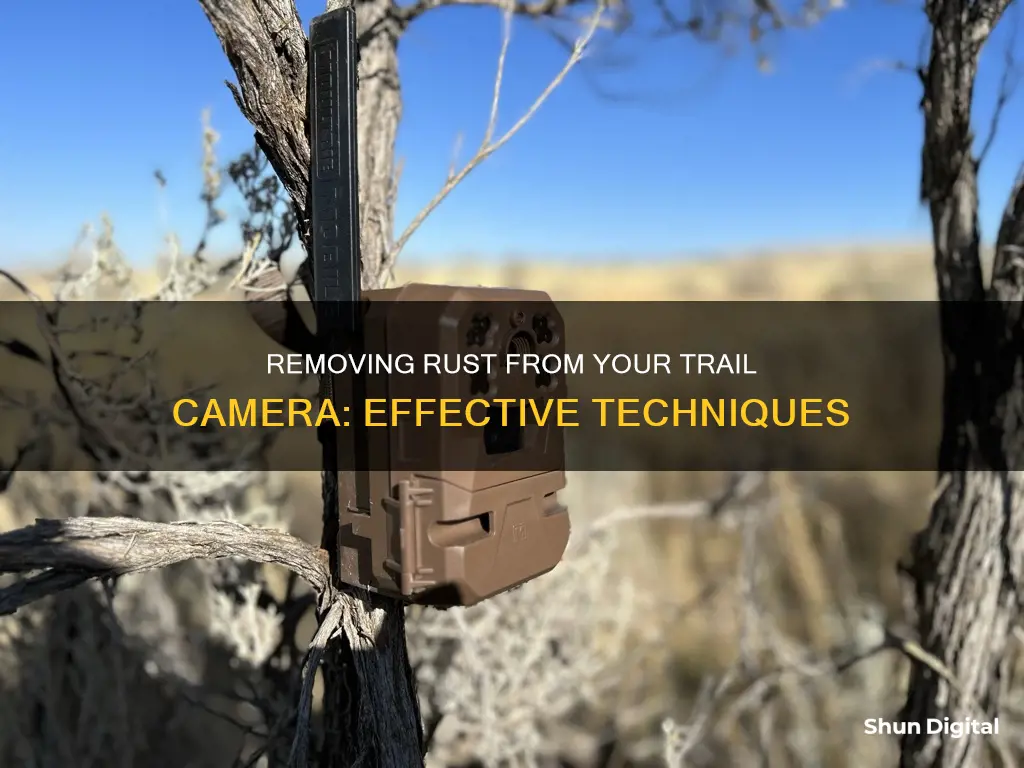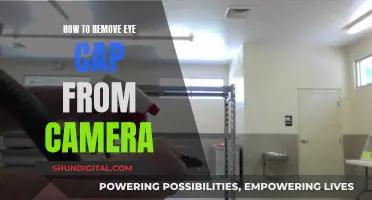
Rust on a trail camera can be a frustrating issue, but it is possible to remove it and restore your camera to its former glory. The process of removing rust involves several steps and the right tools to ensure the job is done effectively and safely. Whether it's a small spot or something more widespread, learning how to remove rust from your trail camera can help you maintain your equipment and keep it in good condition for years to come. In this article, we will explore the different methods and techniques for tackling rust on your trail camera, ensuring that you're well-equipped to handle this common issue.
What You'll Learn

Use a rust neutralizer to treat the affected area
To remove rust from your trail camera, you can use a rust neutralizer to treat the affected area. This is a great option if you are looking to transform the rusty surface into a sandable or paintable material. Rust neutralizers are chemical solutions that contain active ingredients such as tannic acid or phosphoric acid, which work to battle rust and convert it into a stable compound. They penetrate deep into the visible rust and, with the help of polymers, form a protective bond that dries in minutes, creating a surface ready for priming and painting.
- Work in a well-ventilated area and put on safety gear: It is important to work in a well-ventilated area to avoid inhaling any harmful fumes from the chemicals. Put on safety glasses and gloves to protect your eyes and skin from any irritation. You may also want to put down drop cloths to avoid damaging any surfaces.
- Prepare the surface: Use a dust brush or a stiff-bristled brush to remove any loose rust particles, peeling paint, or large rust flakes from the camera. It is important to note that the goal is not to remove all the rust, as rust neutralizers chemically bond and seal in the remaining rust. If there is grease or oil on the surface, clean and degrease it first and let it dry before applying the neutralizer.
- Apply the rust neutralizer: After a light sanding and dusting, it's time to apply the rust neutralizer. You can use a brush or a spray can to apply it to the affected area. Make sure to follow the manufacturer's instructions for the best results. Some products may require a second coat for better coverage and conversion.
- Allow the neutralizer to dry: Rust neutralizers typically dry within 20 minutes. However, it is recommended to let it sit for a longer period, if possible, to ensure a better outcome. If you plan to apply a second coat, wait for at least 24 hours before doing so.
- Prime and paint (optional): Once the neutralizer is dry, you can prime and paint the surface if desired. This step is optional but can provide additional protection and improve the appearance of the camera. Make sure to use oil-based or epoxy-based paints, as latex or water-based paints are not suitable for use over rust neutralizers.
Remember to always handle chemicals with caution and refer to the manufacturer's instructions for specific guidelines on usage, safety, and disposal of any leftover product.
Deleting Cameras from Your HikConnect Account: A Step-by-Step Guide
You may want to see also

Sand the rusted area with a fine-grid nail file
To remove rust from a trail camera, you'll need a few tools and supplies, including fine-grid nail files. Here's a step-by-step guide to sanding the rusted area with a fine-grid nail file:
- Cut off a small portion of the round tip of the nail file to create a square edge. This will help you reach the rusted areas more easily.
- Crease and bend the file twice onto itself at about a 1/2" distance between the bends to create a small triangle at the end. Use super glue to secure the inward tip to the body of the file.
- Protect the surrounding areas of the camera, especially the mirror, by completely covering it with painter's tape. This will prevent accidental scratching or damage during the sanding process.
- Using the flat side of the triangle on the nail file, gently sand the rusted areas. Stop periodically to blow out or vacuum any rust debris, ensuring the camera is facing downward to prevent the spread of rust particles.
- Continue sanding until most of the crusty rust material has been removed. You may need to be patient and gentle during this process to avoid damaging other parts of the camera.
Remember, this is just one step in the process of removing rust from a trail camera. There are additional steps, such as using a rust neutralizer and repainting the treated areas, that are important for effectively removing rust and preventing its recurrence.
Eliminating Camera Grain: Techniques for Crystal Clear Photos
You may want to see also

Clean the area with a microfiber cloth and denatured alcohol
To clean rust from your trail camera, you will need a microfiber cloth and some denatured alcohol.
First, soak the microfiber cloth in denatured alcohol. Ensure the cloth is damp but not dripping wet. You can also pour a small amount of denatured alcohol directly onto the rusted area of the camera if you wish.
Next, use the damp microfiber cloth to wipe down the affected area. Be sure to wipe in one direction only to avoid spreading the rust. Pay close attention to any crevices or hard-to-reach areas, as these may require extra attention. If necessary, use a cotton swab soaked in denatured alcohol to reach these spots.
After wiping down the area, use a clean, dry microfiber cloth to remove any remaining residue. Again, be sure to wipe in one direction only and be gentle to avoid damaging the camera.
Finally, allow the camera to air-dry completely before using it again. This process may need to be repeated for heavily rusted areas or for ongoing maintenance to prevent future rust buildup.
Removing Camera Shortcut from Moto G6 Lock Screen
You may want to see also

Protect the camera lens with painter's tape
To protect the camera lens with painter's tape, you must first acquire the tape. Painter's tape, also known as blue removable tape, can be purchased online or at a hardware store.
Once you have the tape, start by tearing off a piece that is long enough to cover the entire lens. It is important to use too much rather than too little tape. Carefully apply the tape to the lens, smoothing out any air bubbles as you go. Overlapping the tape is fine, as long as the lens is completely covered.
When you are satisfied with the coverage, press down on the edges of the tape firmly to ensure a tight seal. This will help keep out any dust or debris that could damage the lens during the rust removal process.
Now that the lens is protected, you can begin removing the rust from the rest of the camera body.
Removing Moisture from Your Camera: Effective Strategies
You may want to see also

Apply a thin coat of Vaseline to the treated area
To prevent rust on your trail camera, apply a thin coat of Vaseline to the treated area. This is an excellent way to prevent rust from forming on tools and machinery. It is important to note that Vaseline does not remove rust, but it can be used to prevent rust from forming in the first place.
To properly use Vaseline to prevent rust, start by ensuring that the metal surface is clean and dry. Any dirt, debris, or existing rust should be removed before applying the Vaseline. Next, take a small amount of Vaseline and gently rub it onto the metal surface using a clean cloth or your finger. Ensure that the Vaseline is applied evenly and that the entire surface is coated.
It is important to note that Vaseline is not a substitute for proper rust prevention and removal techniques. While it can help to slow down the formation of rust, it is not a permanent solution. For best results, combine the use of Vaseline with other rust prevention methods, such as keeping tools and machinery dry and storing them in a cool, dark place.
Additionally, Vaseline has a variety of other uses, including lubricating skate and skateboard wheels, removing chewing gum from hair, and preventing diaper rash. Its water-resistant properties and protective nature make it a versatile product for many applications.
View Reolink Cameras on Desktop: A Step-by-Step Guide
You may want to see also
Frequently asked questions
Dust and moisture are the most common enemies of your camera. They can cause spots on your photos and major problems with your camera if they get into the wrong areas.
You will need rust neutralizer, black matte acrylic paint, fine-grid nail files, painter's tape, a rubber air pump bulb blower, isopropyl alcohol, glass cleaner, a microfiber cloth, and cotton swabs.
Prevention is always better than cure. After each use, clean and dry your camera, especially if you've been shooting near the water. Use a silicone gun and reel cloth to wipe and protect bare metal parts.
First, cover the camera lens with a small, clean, lint-free cloth to prevent any debris from falling into the camera. Then, use a non-metallic and non-grit tool, such as a pencil eraser, to rub the rust off the surface. If that doesn't work, dab the eraser in silicone oil and try again.







